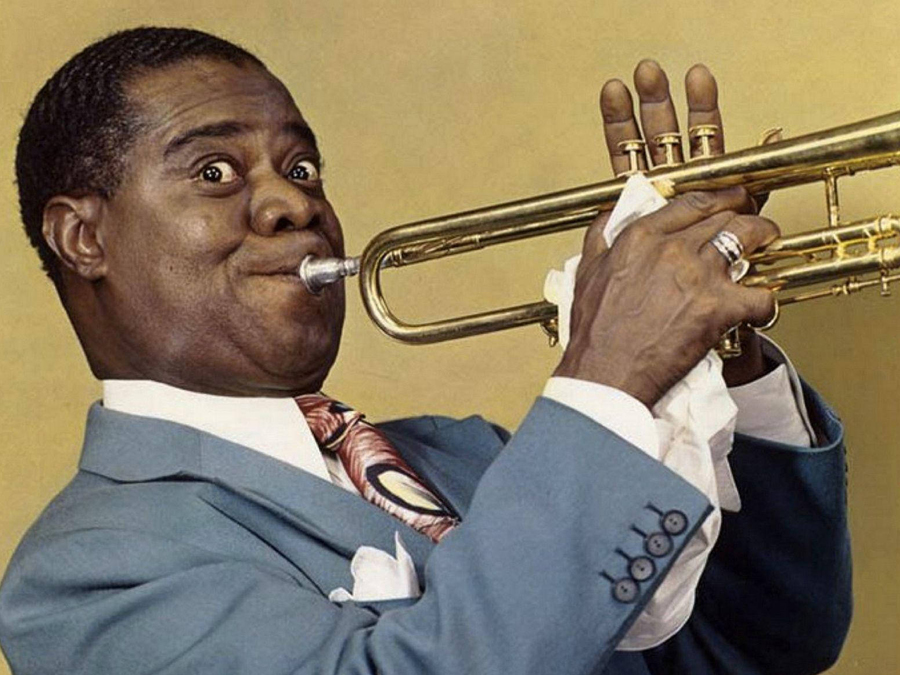Louis Daniel Armstrong, born on August 4, 1901, and passing away on July 6, 1971, was widely known by his nicknames “Satchmo,” “Satch,” and “Pops.” He was a highly influential American artist, composer, singer, and actor, particularly renowned for his impact on jazz music. His illustrious career spanned several decades, from the 1920s to the 1960s, covering various eras within the history of jazz music. In 2017, he was introduced into the Rhythm & Blues Hall of Fame.

Armstrong was born and raised in New Orleans. He rose to prominence in the 1920s as an innovative cornet and trumpet player, becoming a foundational figure in the jazz scene. He shifted the focus of music from collective improvisation to solo performances. Around 1922, he heeded the advice of his mentor Joe “King” Oliver and moved to Chicago to join the Creole Jazz band. In Chicago, he spent time with other renowned jazz musicians, reconnected with his friend Bix Beiderbecke, and collaborated with Hoagy Carmichael and Lil Hardin. He gained fame through “cutting contests” and eventually moved to New York to join Fletcher Henderson’s band.
With his rich and instantly recognizable voice, Armstrong was not only an influential singer but also adept at improvisation, altering the lyrics and melody of a song. He was also skilled in scat singing. Armstrong’s captivating presence and vocal charm were as pronounced as his instrumental prowess. Towards the end of his career in the 1960s, his influence extended beyond jazz into the broader music landscape. Armstrong stood as one of the first prominent African American entertainers to transcend racial barriers in the divided American society. While he rarely publicly engaged in racial politics, this stance caused frustration among African Americans. However, he did publicly express his views during the Little Rock crisis. He managed to access higher social strata at a time when it was challenging for a person of color.
Armstrong appeared in films like “High Society” (1956) alongside Bing Crosby, Grace Kelly, and Frank Sinatra, as well as “Hello, Dolly!” (1969) with Barbra Streisand in a leading role. He garnered numerous awards, including three Grammy nominations and a win for his performance in the song “Hello, Dolly!” in 1964.
Louis Armstrong’s influence extended not only within the realm of jazz but also into the pop music scene of the 1960s. Music commentator Steve Leggett noted that Armstrong could very well be “the single most important figure in 20th-century American popular music.”
Louis Armstrong’s Biography
Louis Armstrong often stated that he was born on July 4, 1900. However, it wasn’t until the mid-1980s that his true birthdate, August 4, 1901, was discovered by Tad Jones through research of baptismal records. At least three other biographies consider the July 4 birthdate to be a myth.
Louis Armstrong was born in New Orleans to Mary Albert and William Armstrong. Mary Albert came from Boutte, Louisiana, and gave birth to Louis when she was around sixteen years old. William Armstrong abandoned them shortly after. About two years later, William had another daughter, Beatrice “Mama Lucy” Armstrong, who was raised by Mary Albert.

Louis Armstrong was raised by his grandmother until the age of five when he was returned to his mother. He spent his youth in a violent neighborhood known as “the Battlefield.” At the age of six, he attended the Fisk School for Boys, a school that accepted African-American children within New Orleans’ segregated system. He did odd jobs for the Karnoffsky family, a Jewish family in Litva. While selling coal in Storyville, he heard spasm bands, groups playing music using household objects. He heard the early sounds of jazz from bands playing in backyards and venues like Pete Lala, where King Oliver performed.
The Karnoffskys treated Armstrong like family, knowing he had no father. They provided him with food and nurturing. In his memoir, “Louis Armstrong + the Jewish Family in New Orleans, La., the Year 1907,” he described his realization that this family also faced discrimination from “other white folks” who felt they were superior to Jewish people. He wore a Star of David pendant throughout his life and learned from them how to live genuinely and resolutely.
Armstrong’s first musical performance might have been alongside the Karnoffsky junk wagon. To stand out from other street vendors, he tried playing a tin horn to attract customers. Morris Karnoffsky gave Armstrong an advance to buy a cornet from a pawn shop.
Despite growing up in extreme poverty and a racially prejudiced town, Armstrong was surrounded by deep and passionate music, known then as “ragtime” before it was called jazz. Despite the hardships of his childhood, Armstrong didn’t see it as a source of sorrow but as an endless source of inspiration. He once said, “Every time I close my eyes blowing that trumpet of mine—I look right into the heart of good old New Orleans… It has given me something to live for.”
Louis Armstrong passed away from a heart attack in his sleep on July 6, 1971, at the age of 69. This was 11 months after his renowned performance at the Waldorf-Astoria. He was residing in Corona, Queens, in New York City at the time of his death. He was buried at Flushing Cemetery in Flushing, Queens, New York.
His funeral procession included notable figures such as Bing Crosby, Ella Fitzgerald, Dizzy Gillespie, Pearl Bailey, Count Basie, Harry James, Frank Sinatra, Ed Sullivan, Earl Wilson, Alan King, Johnny Carson, and David Frost. Peggy Lee sang “The Lord’s Prayer” at the funeral, Al Hibbler sang “Nobody Knows the Trouble I’ve Seen,” and Armstrong’s long-time friend Fred Robbins delivered a eulogy.